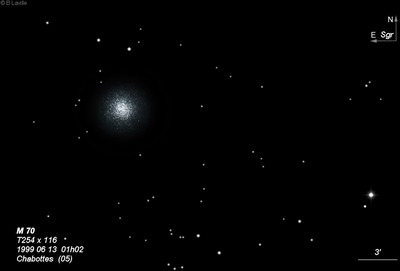
15x50mm IS binoculars (8/3/11): very small, fairly faint glow, brighter center, not difficult.
Charles Messier discovered M70 = NGC 6681 = D 614 = h3756 on 31 Aug 1780 and described "a nebula without star, near the preceding [M 69] and on the same parallel. Near to it is a 9 mag. star and four small telescopic stars, almost in the same straight line, close to one another and situated below the nebula as seen in a reversing telescope. Diam. 2'." On 13 Jul 1784 (sweep 237), William Herschel recorded "easily resolvable, cB, pL, iR. A very faint red perceivable." James Dunlop recorded it on 2 Jun 1826 as "a pretty bright round nebula, about 1 1/2' diameter, very much condensed to the centre." Dunlop claims 5 observations in his catalogue. On 1 Aug 1834 John Herschel recorded "globular, B, R, gmbM, diam in RA = 7 seconds; resolved into stars 14...17m."
200/250mm - 8" few faint stars resolved at high power, bright core. The halo appears flattened on the east side.
300/350mm - 13" very small bright core, faint stars are resolved at the edges. A bright string of stars at the following side trails to the NNE.
400/500mm - 17.5" (7/14/99): At 220x, M70 displays a 3' round halo and is very well concentrated to a small bright core and intense nucleus. A string of three brighter stars extends to the north from the northeast end and a number of stars are resolved in the halo. At 280x, ~15-20 faint stars are resolved in the halo and at the edge of the core, particularly on the south side over a very lively background.
Notes by Steve Gottlieb